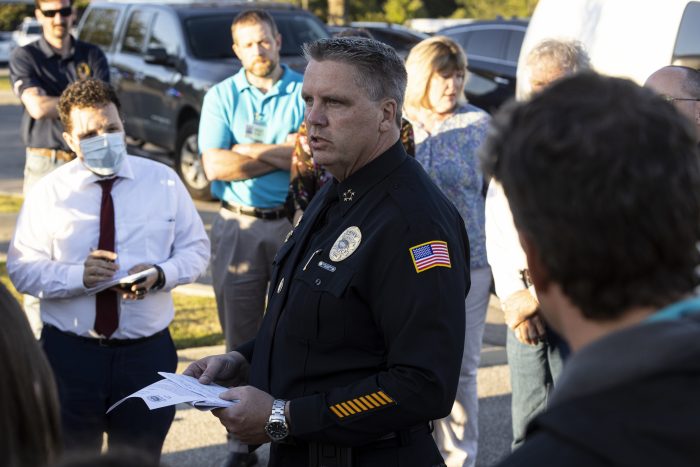
The day after a man opened fire at a Collierville, Tennessee, grocery store, killing one person and wounding 13 others before turning the gun on himself, local police conducted an impromptu news conference to identify the perpetrator.
But instead of saying the suspect’s name out loud on that sunny morning in September 2021, Collierville Police Lt. David Townsend held up a yellow piece of paper with the name “Uk Thang” and the birth date “10-17-91.”
Nothing else was said about the suspect at the press conference, other than that he was a “third-party vendor” for the store. Later reporting determined he was the franchise operator for the sushi counter at the store, but he was not a Kroger employee.
That press conference has become typical of the way law enforcement has reacted after mass shootings: Never mention the suspect’s name or offer much information about the person. The goal is to encourage the news media to avoid using the perpetrator’s name and thus deprive the perpetrator of publicity. As my research has found, for the past 10 years the news media has followed suit by reducing the number of times the name of a mass shooter is reported.
Now that the suspect has been arrested, it will be interesting to see how the news media handles the reporting of the name of the alleged perpetrator of the April 12, 2022, Brooklyn subway shooting. Many mass shootings end with suspects turning the weapons on themselves or being killed by police. The Brooklyn suspect initially evaded capture, so police revealed the name as part of efforts to arrest him.
But is reducing the number of times the perpetrator’s name is used in news coverage in the public interest? It certainly diminishes the notoriety of the perpetrator and reduces any incentive to become famous.
Yet when the name is not used, other more relevant details, such as the person’s motives and background, may also not be reported.
I got interested in the issue after several high-profile mass shooting perpetrators were not named out loud by police in the aftermath of attacks. And it seemed that the news media followed suit.
I analyzed how often perpetrators were named in news articles within a week of mass shootings between 1999 and 2021.
The research, not yet published, examined mass shooting news coverage starting with the Columbine High School killings in 1999 and ending with the Indianapolis FedEx hub killings in 2021. My findings confirmed what previous research had shown: The more deaths there were, the more news reports used the perpetrator’s name. That was true for the entire time period.
But there was a turning point in 2012. Taking into consideration the number of people killed in a mass shooting, the number of times the news media used the perpetrators’ name in news reports started to decline.
After a July 2012 mass shooting at a Colorado movie theater, relatives of the victims asked that the state’s governor not to mention the perpetrator’s name at a memorial service where the victims’ names would be read. Victim advocates and family members wanted to give no publicity to the killer out of concerns that notoriety was one of the perpetrator’s motives.
The governor’s public remarks referred to the shooter only as “Suspect A.” Later that year, the mass shooting of elementary school children and school staff in Newtown, Connecticut, shocked the nation. In that case, the name of the perpetrator in the Sandy Hook Elementary School shooting was widely circulated in news reports.
The decision to avoid naming mass shooting perpetrators is based on the idea that people who engage in mass shooting attacks do it out of the desire for publicity. Certainly, there is anecdotal evidence that some mass shooters use the media to gain notoriety from their attacks. The 2007 Virginia Tech shooter paused his killing spree to mail photos of himself to NBC News. The 2014 Isla Vista shooter posted a manifesto on YouTube before he began killing.
Certainly news organizations can dig deep into the backgrounds of mass shooters without ever naming the person. My research did not determine whether reducing the times a mass shooter is named was connected with reducing the amount of coverage of mass shooters’ background and motives. But the name is a concrete, basic piece of information about a person.
Supporters of not naming perpetrators make the case that the less written, spoken or known about the perpetrators, the better. It also eliminates any incentive for perpetrators to become famous from such horrific acts. Whether this trend of reducing the naming of mass shooters helps reduce mass shootings or perhaps makes them more likely is not something my research can determine.
Mass shootings happen for a host of reasons. Lax gun laws in the U.S. and the lack of mental health services are two of the most discussed reasons. Some say they are unavoidable random events that cannot be stopped.
It is not yet clear how much notoriety is a factor for potential shooters. But we do know that the news media is heeding the call to limit naming perpetrators in mass shootings.
Thomas J. Hrach is associate professor in the department of journalism and strategic media at the University of Memphis. This article is republished from The Conversation under a Creative Commons license.![]()